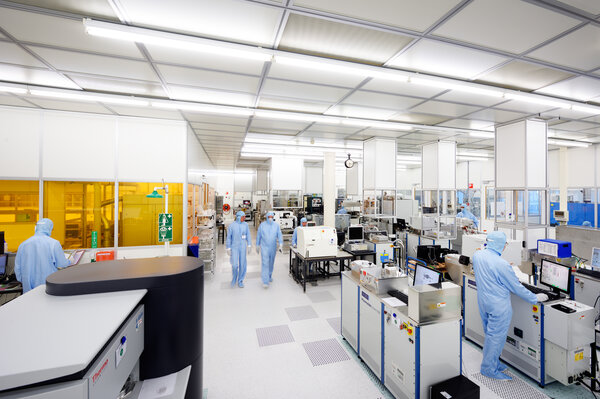7 out of the 14 awarded NWO HTSM grants go to TU/e

NanoLEDs and nanoelectronics, novel antennas for future 5G/6G wireless communications, ultrasound imaging for cardiac dysfunctions, water-based inks for high-quality printing, and improved monitoring of sleep apnea: those are the research topics from TU/e that were granted within the NWO High Tech Systems and Materials (HTSM) programme. Seven out of fourteen awarded grants went to TU/e scientists, all within the departments of Applied Physics and Electrical Engineering.
The annual NWO grant on High Tech Systems and Materials (HTSM) encourages researchers and companies to jointly develop fundamental knowledge for technological breakthroughs and innovative applications. Thanks to the 8 million grant scheme awarded last Friday, fourteen research projects will be financed all over the country. Seven out of the fourteen grants went to TU/e scientists, for a total budget of approximately 3.5 million euros.
The awarded projects from TU/e are (in alphabetical order):
Master Equation Modeling of Organic Light-Emitting Diodes (MEMOLED)
Rational design of organic light-emitting diodes (OLEDs) and organic photovoltaic (OPV) devices requires accurate modeling of processes occurring at the molecular scale. In the OLED and OPV manufacturing industry there is strong demand for accurate but also efficient mathematical models. MEMOLED will be devoted to the development of accurate and fast mathematic models, which will fill the existing gap in the rapidly growing market of organic device modeling. Research will be performed by Peter Bobbert, Associate Professor in the group Molecular Materials and Nanosystems within the department of Applied Physics, in collaboration with the software company Simbeyond, which will commercialize the tool.
NanoLEDs: bringing nanophotonics into solid-state lighting
Nowadays, blue light emitting diodes (LEDs) are abundantly used for general lighting, automotive, projection and displays. These LEDs are operated at daunting power densities and temperatures to generate very high white light illumination levels. These operation conditions require tight control over efficiency budgets and material performances. In this project, prof. Jaime Gómez Rivas from the Surface Photonics groups of Applied Physics, will study the implementation of nanostructured surfaces designed to interact optimally with the emission of LEDs, in order to boost blue light emission and white light conversion efficiencies.
Novel antennas for future 5G/6G wireless communications
Future 5G/6G wireless communications require antennas with millimeter-waves to connect central sources to remote radio units. In this project, led by prof. Bart Smolders from the Electromagnetics Group of Electrical Engineering, a novel antenna system will be developed, which is based on array of transmitters and power-efficient amplifiers, which promise to reduce the power consumption of at least a factor of 100.
Novel plasma processes for nanoelectronics
The fabrication of future sub-5-nanometer electronics requires etching with atomic level accuracy, which is beyond the reach of conventional plasma etching technology. In this project, novel plasma-based processes will be developed for layer-by-layer removal of material using atomic layer etching (ALEt). Adrie Mackus, leader of this project and Assistant Professor at the Plasma and Materials Processing group of Applied Physics, will collaborate with a diverse group of users from industry and academia, strengthening the leading position of the Netherlands in semiconductor equipment manufacturing.
Novel ultrasound technique for cardiac dysfunctions
Atrial fibrillation and ventricular tachycardia are two cardiac dysfunctions associated with increased risk of stroke and life-threatening ventricular fibrillation, respectively. Cardiac ablation (CA), the formation of lesions by ablation using an intra-cardiac catheter, is increasingly used to treat both atrial and ventricular fibrillation. Long term success of CA is relatively low and the procedure carries serious risks. The research led by Massimo Mischi, Full Professor at the Signal Processing Systems group of the Electrical Engineering Department, aims at developing a novel ultrasound imaging approach, which is optimized for accurate monitoring of tissue structure and lesion formation and might lead to effective and safer CA procedures.
Print Quality and Particles (PQP) project: water-based inks for high-quality inkjet printing
Inkjet printing is progressively shifting towards the use of water-based inks for environmental reasons. As most printing substrates are porous, inks might migrate deep into the substrates, leading to loss of print quality. Henk Huinink, Assistant Professor at Applied Physics and leader of the Print Quality and Particles (PQP) project, will investigate the motion of particles into porous media via mathematical models to understand the relation between penetration depth and the particle-substrate interaction. The obtained data will be used to develop a novel class of inks for high-quality inkjet printing.
Unobtrusive Monitoring of Sleep Apnea (UMOSA)
Sleep apnea – one of the most common sleep disorders - remains undiagnosed, or even unnoticed, due to both unawareness of its symptoms and the complexity of current diagnostic methodologies, the latter relying on a number of obtrusive sensors attached to the patient’s body. In the project UMOSA, led by Assistant professor Sander Stuijk from the Electronic Systems group of Electrical Engineering, contactless technologies will be developed to guarantee continuous, accurate and robust measurements of, among others, heart rate, respiration rate and nasal flow. Each technology will be clinically validated at a sleep-institute. When successful, this project will have a direct impact on current sleep medicine diagnostics and a far-reaching impact for other patient groups, as, for example, those in intensive care unit settings.
The HTSM programme is an annual call from the NWO domain ‘Toegepaste en Technische Wetenschappen’ (TTW). Read more.